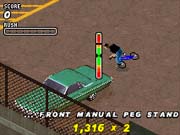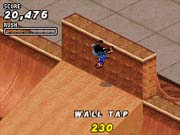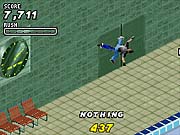Dave Mirra GBA Q&A
We get the skinny from Dave Mirra GBA developer Full-Fat.
The Game Boy Advance is quickly turning into a platform where developers can showcase their coding skills. With the latest batch of home consoles offering developers a great deal of freedom in terms of what they can accomplish in a game, impressive graphics are becoming a bit easier to come by. Portable consoles, on the other hand, have always presented developers with a challenge, due to their limitations. While the GBA certainly has its limits, developers seem to be coaxing some truly impressive things out of the tiny system. One of the upcoming games for the system, Dave Mirra Freestyle BMX 2, looks to be wringing quite a bit of performance out of the GBA. We were able to touch base with Paul Adams, managing director of Full-Fat, the developer of Dave Mirra 2, and find out about the game and what developing on the GBA is like.

GameSpot: How has it been developing on the Game Boy Advance? Have you discovered anything cool about the hardware?
Paul Adams: The GBA is an extremely nice piece of hardware and has a huge amount of potential. What you can achieve is down to tight code and cunning techniques for making the most of the available video and work RAM. Having tight hardware constraints always makes you try and squeeze every last cycle out of the machine. For us, we think the pure flexibility of the hardware is its coolest asset. There is so much you can make it do that it isn't exactly designed for. It comes down to persuading the hardware to do what you want it to, such as Mode-7 for instance.
GS: How long has the game been in development?
PA: We started the design for the game in January 2001 and began full development around mid-February. We finally got approval from Nintendo round about mid-October. So from start to end about nine months--a good gestation period!
GS: What's the size of the team working on the game?
PA: In the height of development there was a team of nine development staff working on the project, including 3D animators, bitmap artists, and programmers, plus all the support staff back in the States--producers, bug testers, etc.

GS: How do you approach bringing a game like Dave Mirra to the GBA?
PA: Good question. The simple answer is good solid research. We spent a great deal of time playing Mirra on PS1 and Game Boy Color, as well as Tony Hawk on the PS1. We went to live shows to watch the pros in action (which was cool!). There was also a lot of time spent online, checking out the BMX sites and generally gaining an understanding of the sport. From this research we then got a real flavor of what we intended to do in the game itself. There was a push from Acclaim US too, with some of the guys over in the States having a keen interest in the sport, which is very helpful when you don't know what some of the tricks are. We then had to take into account what the GBA was capable of. Being a new platform it was pretty tricky (no pun intended) to determine exactly what it could do. That's where the coders come into their own. From here on in it's then a case of taking all the ideas and creating a design doc and then developing the thing.
From a technical point of view you have to look at the existing games and consider what is possible from the hardware you are developing for. In the case of Mirra PS1 we obviously couldn't create that sort of polygon-rich environment on the GBA, and similarly we knew we could do a great deal better than the GBC version. So we ended up with a compromise between the two, with highly detailed static backgrounds and a fluid polygon rider.
GS: What was your goal going into the project, in terms of what you wanted to accomplish with the game?
PA: The main goal initially was to improve on the GBC version, which, at the time, we were very impressed with, no disrespect to Neon studios (they did a fantastic job on this). But we felt it crucially important to improve the fluidity of movement, improve the handling, interaction, and controls. Overall, we have tried to pull the handheld version closer to the PS1 (and now PS2) versions rather than being a stand-alone game developed specifically for GBA.
GS: Did you look to the PS2 version for inspiration at all?
PA: Initially, the PS2 version wasn't finished. We did gain access to the resources that Z-Axis used (motion captures, textures, etc.), but we had to go back to the PS1 versions and use those as a benchmark. Towards the end of development, however, we did manage to get our hands on a copy of the beta builds of the PS2 version, by which point we'd nearly finished too. So in answer to your question, no and yes.

GS: What were the key gameplay elements that you felt had to come over?
PA: Grace, style, and fluidity. The main thing for us was to differentiate the sport of BMX with the sport of skateboarding. We knew from the off it would get compared to Hawk (despite the fact that the GBA version of Hawk hadn't been announced when we started). The main difference between skating and BMX is the speed of tricks--where skating is lightning fast and you've got no brakes (it's more like controlling a runaway train), in BMX the tricks are more graceful and, to a certain extent, slower to execute (because of the fact that a bike is so big and heavy compared to a board).
For us, one of the things that Mirra has over the immediate competition is that it recognizes the sport of BMX for what it is--it's on bikes. Bikes are heavy and cumbersome, and as such the game was designed to reflect this. However, in order to make it fun to play, we threw caution to the wind but developed the game with this concept in mind. If we were to keep it too realistic, then you wouldn't have much fun playing it, so we have tried to make it as user friendly as possible--a fine balancing act that we think we've managed to pull off.
We have tried to make full use of the wall tap and wall ride features, and landing back into stalls on the lips of verts after pulling big airs is great fun. I can't stop playing the damn thing, and usually at the end of the dev cycle I can't wait to see the back of the project, but it keeps on pulling me back, which I think demonstrates the draw of the game.
GS: How important was the multiplayer component in the game?
PA: The multiplayer component was very important; however, we didn't have the time to fully implement the link cable options. In Mirra, we have more levels and, more importantly, more tricks than Hawk, and we felt these issues were more important than trying to rush something that would take time to implement correctly. As an alternative to the link-up option there are multiplayer features, but it's not simultaneous. Maybe Mirra 3.
GS: How much of an influence was Tony Hawk on the GBA?
PA: Now you're talking about the GBA version, which (at first) wasn't an influence at all. We had been developing Mirra for a good five months by the time Hawk came on the scene. The question is, "How gutted were you when Hawk GBA appeared?" The answer: very. But I'll get into that in a moment. The PlayStation version is something that we have all played to death. I don't really know anyone that hasn't played it and loved it, so yes, Hawk PS1 was a very definite influence. How can you not be influenced by it?
When the GBA version hit the headlines we were in mid-development of Mirra, and we knew we were onto something special with it. No one else at the time (or so we assumed) had even thought of using 3D for rendering the sprites in real time. It was pretty obvious though that the only way to get all the tricks and moves we wanted onto the cart was to develop a 3D renderer. Our lead engineer had already developed 3D engines on the same chipset as the GBA, so for him it was a pretty easy task (I'm sure he'd say otherwise!). Then VV and Activision started the Hawk promotional ball rolling, and we felt the wind leave our sails. In fact, we spent the best part of the first few days after Hawk GBA was announced lying on our backs staring at the ceiling, with a blank look on our faces, but we still knew we had something really special. Hawk GBA is a fine example of what the little machine is capable of. I don't think there are any other titles out there that are pushing the hardware as much as Full-Fat is on Mirra and VV is with Hawk.
GS: Was there anything you didn't have time to implement?
PA: Yes, plenty. There always is with game development. Some things had to be ditched at the last minute due to lack of time--replays for one. Again another frustrating thing for us--we'd had the replays in and working perfectly right from day one, then in the final days of bug testing some nasty crash bug got introduced into the replays that we didn't have time to track down, so we had no alternative but to pull the feature! We also wanted to implement flatland tricks into the mix (these are tricks done on the flat, which is a discipline of BMX, which is often overlooked, not only in games but in the sport too). We'd have loved to have done it, but we had to omit these in favor of aerial tricks, which after all is the main draw of the genre.
Thanks to Paul Adams for his time.
Got a news tip or want to contact us directly? Email news@gamespot.com
Join the conversation